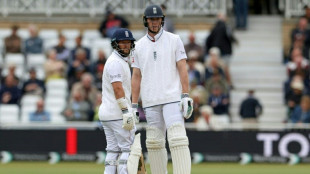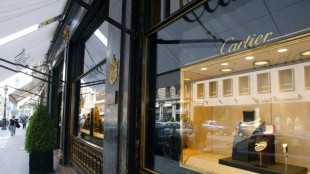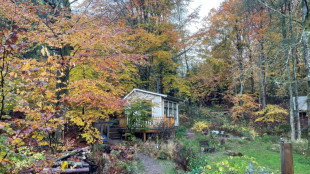
-
 Duckett and Crawley on fire in England Ashes warm-up
Duckett and Crawley on fire in England Ashes warm-up
-
Sumo grapples with ancient rule in age of woman PM

-
 Cartier owner sales lifted by jewellery, improving Asia
Cartier owner sales lifted by jewellery, improving Asia
-
Markets sink on concerns over tech rally, Fed rates

-
 Over 500 economists, top experts call for G20 inequality panel
Over 500 economists, top experts call for G20 inequality panel
-
Four killed in 'calculated' Russian attack on Ukraine: Zelensky

-
 What we know about deadly Delhi car blast
What we know about deadly Delhi car blast
-
Sweden sees silent forests as sanctuaries from a noisy world

-
 Ecuador to vote on foreign troops, constitutional reform
Ecuador to vote on foreign troops, constitutional reform
-
Italian fruit detective racing to save forgotten varieties

-
 As AI data scrapers sap websites' revenues, some fight back
As AI data scrapers sap websites' revenues, some fight back
-
Peru's interim president embraces the spotlight in 'war' on crime

-
 China retail sales grew at slowest pace in over a year
China retail sales grew at slowest pace in over a year
-
Tobacco conference to weigh up stubbing out cigarette butts

-
 Suns scorch depleted Pacers, Hawks hold off Jazz
Suns scorch depleted Pacers, Hawks hold off Jazz
-
Henderson scores three touchdowns as Patriots top Jets

-
 Bad Bunny wins top album prize at Latin Grammys in Vegas
Bad Bunny wins top album prize at Latin Grammys in Vegas
-
Curacao thrash Bermuda 7-0 to top World Cup qualifying group as Jamaica held

-
 Ukrainian capital comes under 'massive' attack
Ukrainian capital comes under 'massive' attack
-
MAGA civil war: How a white nationalist blew up the American right

-
 Muntz eager to 'unleash weapons' from Fiji backline against France
Muntz eager to 'unleash weapons' from Fiji backline against France
-
Galthie's France aim to 'come through' Boks defeat with Fiji match

-
 Young diners 'time travel' back to ancient China
Young diners 'time travel' back to ancient China
-
Rise of the robots: the promise of physical AI

-
 Itoje summons spirit of 2019 as England bid for New Zealand win
Itoje summons spirit of 2019 as England bid for New Zealand win
-
Australia capable of upsetting 'flat' Irish, says MacNeill

-
 Asian markets sink on concerns over tech rally, Fed rates
Asian markets sink on concerns over tech rally, Fed rates
-
Video podcasts become next streaming battleground

-
 Ukraine capital under 'massive' attack: Kyiv mayor
Ukraine capital under 'massive' attack: Kyiv mayor
-
Trump eyes $2,000 checks, 50-year mortgages as economic fears loom

-
 Dodgers' Ohtani wins fourth MLB MVP award, Yankees' Judge bags a third
Dodgers' Ohtani wins fourth MLB MVP award, Yankees' Judge bags a third
-
England stars buy into team-first mantra: Tuchel

-
 Fight over fossil fuels drawdown looms at UN climate summit
Fight over fossil fuels drawdown looms at UN climate summit
-
Blue Origin launches NASA Mars mission and nails booster landing

-
 Ronaldo red 'nothing to do with me': Ireland coach
Ronaldo red 'nothing to do with me': Ireland coach
-
France qualify for World Cup as Portugal, Norway forced to wait

-
 US says trade talks with Swiss 'very positive'
US says trade talks with Swiss 'very positive'
-
Brazil rebuts UN complaint about COP30 security, but boosts presence

-
 Swiss Gruyere crowned world cheese champ
Swiss Gruyere crowned world cheese champ
-
Palestinian Authority says Israel killed two teens in West Bank

-
 Blue Origin launches NASA Mars mission and sticks booster landing
Blue Origin launches NASA Mars mission and sticks booster landing
-
Stocks slide despite end of US government shutdown

-
 MLS to align calendar with world's top football leagues
MLS to align calendar with world's top football leagues
-
BBC says sorry to Trump, but rejects defamation claim

-
 Mbappe, Olise star as France seal spot at 2026 World Cup
Mbappe, Olise star as France seal spot at 2026 World Cup
-
Ronaldo sent off as Ireland stun Portugal in World Cup qualifier

-
 England cruise against Serbia with Bellingham reduced to cameo role
England cruise against Serbia with Bellingham reduced to cameo role
-
Alcaraz beats Sinner to year-end world number one after defeating Musetti at ATP Finals

-
 Eagles aim to keep rolling despite Brown turmoil
Eagles aim to keep rolling despite Brown turmoil
-
Alcaraz to end year as world number one after seeing off Musetti at ATP Finals

| RBGPF | -3.73% | 75.65 | $ | |
| CMSC | -1.05% | 23.83 | $ | |
| BCC | -1.59% | 69.18 | $ | |
| CMSD | -1.4% | 24.21 | $ | |
| JRI | -0.73% | 13.77 | $ | |
| SCS | -0.83% | 15.62 | $ | |
| BCE | 1.47% | 23.11 | $ | |
| NGG | 0.08% | 78.09 | $ | |
| RIO | -0.1% | 71.04 | $ | |
| GSK | 0.15% | 48.14 | $ | |
| RYCEF | -0.34% | 14.91 | $ | |
| BTI | -2.46% | 54.48 | $ | |
| RELX | 0.14% | 41.42 | $ | |
| VOD | 0.32% | 12.41 | $ | |
| BP | -1.01% | 36.49 | $ | |
| AZN | 1.05% | 88.61 | $ |

Italian fruit detective racing to save forgotten varieties
Isabella Dalla Ragione hunts in abandoned gardens and orchards for forgotten fruits, preserving Italy's agricultural heritage and saving varieties which could help farmers withstand the vagaries of a changing climate.
The 68-year-old's collection of apples, pears, cherries, plums, peaches and almonds, grown using methods of old, are more resilient to the climate shifts and extremes seen increasingly frequently in the southern Mediterranean.
The Italian agronomist-turned-detective seeks descriptions of bygone local fruits in centuries-old diaries or farming documents, and sets out to find them.
Others she identifies by matching them to fruits in Renaissance paintings, where they often appear in depictions of the Madonna and Child.
Of the 150 or so varieties collected from Tuscany, Umbria, Emilia-Romagna and Marche and grown by her non-profit Archeologia Arborea foundation, the small, round Florentine pear is among Dalla Ragione's favourites.
"I'd found it described in documents from the 1500s, but I'd never seen it and believed it lost," she told AFP.
"Then 15 years ago, in the mountains between Umbria and Marche, I found a tree almost in the middle of the woods," thanks to an elderly local woman who told her about it by chance.
While old varieties are flavoursome, most disappeared from markets and tables after the Second World War as Italy's agricultural system modernised.
- 'Urgent' -
Italy is a large fruit producer. Its pear production ranks first in Europe and third globally, but just five modern varieties -- none of which are Italian -- account for over 80 percent of its output.
"There used to be hundreds, even thousands, of varieties because each region, each valley, each place had its own," Dalla Ragione said as she showed off wicker baskets full of fruit, stored in a little church near the orchard.
Modern markets instead demand large crops of fruits that can be harvested quickly, easily stored and last a long time.
But as global warming makes for an increasingly challenging climate, experts say a broader range of plant genetic diversity is key.
"Heirloom varieties... are able to adapt to climate change, to more severe water shortages, to extremes of cold and heat," said Mario Marino, from the climate change division of the UN's Food and Agriculture Organization.
"However, a much more severe disease arrives, one that improved varieties are normally more resistant to... and the local varieties perish, or perhaps don't produce fruit," he told AFP.
The answer lies in creating new varieties by crossing modern and old-fashioned ones, he said.
Marino, who advises Dalla Ragione's foundation, said her work was "urgent" because "preserving one's heritage means preserving the land, preserving biodiversity... and (allowing) us to use that DNA for new genetic resources".
- Oral testimonies -
Researchers can access the collection, while Dalla Ragione also recreates historical gardens which can host recovered varieties as part of an EU-funded project.
"We don't do all this research and conservation work out of nostalgia, out of romanticism," she said as she harvested pink apples from her trees in the hilly hamlet of San Lorenzo di Lerchi in Umbria.
"We do it because when we lose variety, we lose food security, we lose diversity and the system's ability to respond to various changes, and we also lose a lot in cultural terms."
Dalla Ragione has sought answers to fruit mysteries in monastery orchards, the gardens of nobility and common allotments. She has pored over local texts from the 16th and 17th centuries.
She once traced a pear to a village in southern Umbria after reading about it in the diary of a musical band director.
But one of her richest sources on how best to cultivate such varieties has been oral testimonies -- and as the last generation of farmers that grew the crops die, much local knowledge is lost.
That has made it difficult to know how to divide her time between researching and looking for a new variety, though she has learnt the hard way that the urgency "is always to save it".
"In the past if I've delayed, thinking 'I'll do it next year', I've found the plant has since gone".
P.Staeheli--VB



